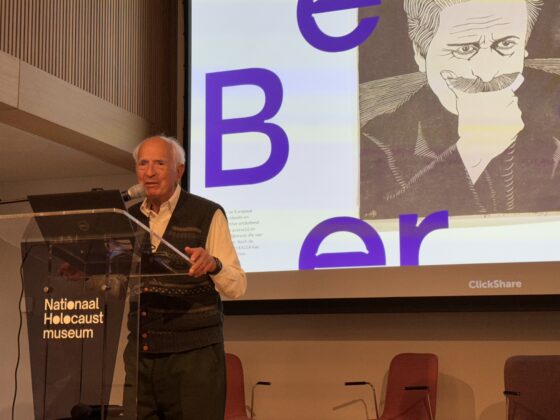Stories of loss: new exhibition on looted Jewish objects
Senay Boztas
In the middle of a glass case are two leather insoles. Look a little closer at these boot inlays, and you see the handwritten Hebrew of a Torah parchment, a part of Jewish cultural identity which the Nazis quite literally stole and stamped upon.
An extraordinary exhibition at the National Holocaust Museum and Jewish Museum in Amsterdam tells stories about all kinds of Nazi looting during the occupation of the Netherlands from 1940 to 1945 – from the confiscation of hugely valuable, Jewish-owned artworks to these shoe soles.
Through the prism of eight personal stories, it documents the Nazis’ systematic efforts to trample Jewish identity, pillaging valuables and sacred objects, destroying and misusing precious archives, then isolating and murdering three-quarters of the Dutch Jewish population. Rather than being a story of money, it looks at the effects of losing precious objects on individual people.
“This theft was a lot more complex than the big cases we all know of looted art,” said Emile Schrijver, director of the Holocaust Museum at a press opening. “We thought it was also important to name the other aspects, the things that happened to ordinary people, which don’t normally feature in the press – the normal, small thefts that every single Jewish family experienced in the Second World War in all kinds of ways.”
The exhibition is based on a decade of investigation from the Rijksmuseum and years of research by curators at the Jewish Museum. “An essential part of the Holocaust was the systematic theft from Jewish people in the Netherlands,” said Taco Dibbits, general director of the Rijksmuseum.
“This is something that is still often a little overlooked, people think of theft as something impulsive, but this was also organised and systematic: isolation, theft, displacement, and then murder. And in this exhibition, we think it is important to put the stories of people in the centre, because these thefts changed their lives forever.”
Five of the stories are shown in the new Holocaust Museum, including the story of Dési Goudstikker-Halban, the wife of art dealer Jacques, who fought with the Dutch state for years to try to get back his art collection and eventually agreed a settlement. Another is about the heirs of Johanna Margarethe Stern-Lippmann, whose Kandinsky painting, View of Murnau with church, was repatriated after a long battle in 2022, and sold by Sotheby’s this year.

Disappeared
Other stories are about precious objects, far less well-known to the public and shown in a partner display in the nearby Jewish Museum. One is of Louis Hirschel and his religious books, stolen and used for purposes such as those Nazi boot insoles or painting a portrait of a Nazi soldier – shown sideways in this show so that the Hebrew on the true side is the right way up.
Antiquarian book handler Louis Lamm, for instance, fled from Berlin to Amsterdam in 1933. Within a decade, his business had been plundered by the Nazi’s and he was deported and murdered – with most of his collection obliterated. A collection of 1,000 Jewish ritual objects sent to him for safekeeping by prominent Jewish publisher Leo Isaac Lessmann also disappeared, without a trace. “I have not given up looking,” said curator Julie-Marthe Cohen.
Making the point that these losses were about so much more than financial value, the exhibition also shows videos of survivors and descendants talking about the impact of systematic cultural theft. Amichai Heppner, one of them, suggested at the press opening that telling these tales in public was also a form of catharsis: “I do not want to be seen as a victim,” he said, “but as a storyteller.” Realising and remembering the losses of Dutch Jewish people during World War II is part of the story.
Looted: personal stories about the looting and restitution of Jewish cultural property, runs from May 31 until October 27
Thank you for donating to DutchNews.nl.
We could not provide the Dutch News service, and keep it free of charge, without the generous support of our readers. Your donations allow us to report on issues you tell us matter, and provide you with a summary of the most important Dutch news each day.
Make a donation